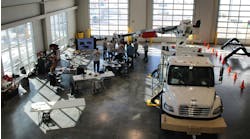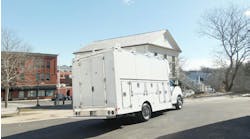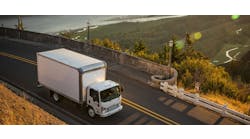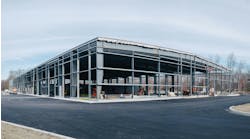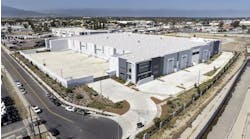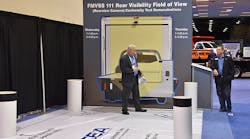If you’re a Truck-Body Builder and you’re unaware of the rear-visibility regulation that kicked in May 1, then you’re not a regular reader of our magazine, nor a member of NTEA. This Federal Motor Vehicle Safety Standard (FMVSS) 111: Rear Visibility deadline has been several years in the works and NTEA has been preaching and teaching from the get-go. And TBB has duly reported and relayed the NTEA message.
So much so, as I discovered in putting together our annual Work Truck Show issue this month, that we could have rerun last year’s coverage of the phase-in, and just changed the May 1, 2017 date for this year’s full implementation.
My predecessor here at TBB, Bruce Sauer, and I even had virtually identical photos of NTEA Technical Assistance Director Steve Spata’s demonstrations from the exhibit hall floor at WTS. I sat through two of them at the show last month because I didn’t quite get it the first time. But after the second demonstration, I thought I had a pretty good grasp of one key element of FMVSS 111: You can’t just make sure the rear-view camera is mounted and generally aimed rearward. Verification is going to be complicated, especially if you, as a body builder, have to relocate the OEM-installed camera from its FMVSS 111 compliant position. And if you build a variety of truck bodies, each one will have to be certified.
Not to scare anyone, but it occurred to me that many TBB readers may well be aware of the rule but just never paid close attention—and so they might be in for a surprise. And that’s why I’m serving notice here at the front of the magazine this month: Get educated.
If you’re lucky, or even better, if you’re good, FMVSS 111 is just another technical requirement and you have procedures in place, the right staff, equipment and expertise to handle it. But to someone new to the work-truck world, this doesn’t look at all easy to yours truly. Fortunately, NTEA is on the job, and I’ll summarize Spata’s key points.
First, the standard applies to vehicles with a 10,000-pound or less gross vehicle weight rating (GVWR), including trucks, buses, school buses and multipurpose passenger vehicles.
Rear-vision systems must meet seven performance elements—one of which (the field of view requirement) started phasing in a year ago. You’ll need to set up a 10-foot-by-20-foot area directly behind the vehicle for visual confirmation of specific test objects in the monitor.
Along with field of view, the other six performance requirements (image size, response time, linger time, deactivation, default view and durability) come into full effect May 1. Most of these seven performance requirements involve system hardware and electronics characteristics of vehicle OEMs and their suppliers. However, Spata notes, as with field of view, image size can also be affected by position and orientation of a rear-vision camera.
That means proper camera location/relocation will need to include considerations for meeting the image size requirement when completing or altering vehicles. The good news: NTEA offers resources for upfitters to evaluate conformance with the field-of-view portion of these requirements. But there’s a catch: The methodology for evaluating image size requires highly specialized equipment used under laboratory conditions. As Spata notes, such test methods are more suited for high-volume, low-variation vehicle production (think OEMs).
But TBB readers don’t mass produce their vehicles, so following chassis OEM guidance for meeting image size requirements in body builder books, bulletins and incomplete vehicle documents “will be critical,” Spata emphasizes.
Another challenge comes from the timing of the compliance dates, which are a result of the Congressional mandate associated with these requirements (and that always means fun—my note, not Spata’s). Truck OEMs are on the same compliance schedule as body builders and upfitters. This means while OEMs are bringing their rear-vision systems into full compliance, final-stage manufacturers have the same responsibilities at the same time—but possibly without any experience with these systems.
(Congratulations if you’re upfitting trucks in Canada: Transport Canada recognized the problem and extended the effective date for the equivalent requirements, giving the work-truck industry there an additional year.)
So, what’s a work-truck builder to do?
First, as computer kids today like to say: RTFM, dude; or, read the fine manual. Keep up with your OEM upfitter resources as they provide the latest information related to rear vision systems, camera relocation and box removal.
Finally, for a clearinghouse of all things FMVSS 111, see the NTEA resource page. They have gathered a wealth of info, much of it available to non-members. They also have a kit available for order that can be used to set up a testing area at your facility.
Good luck.

